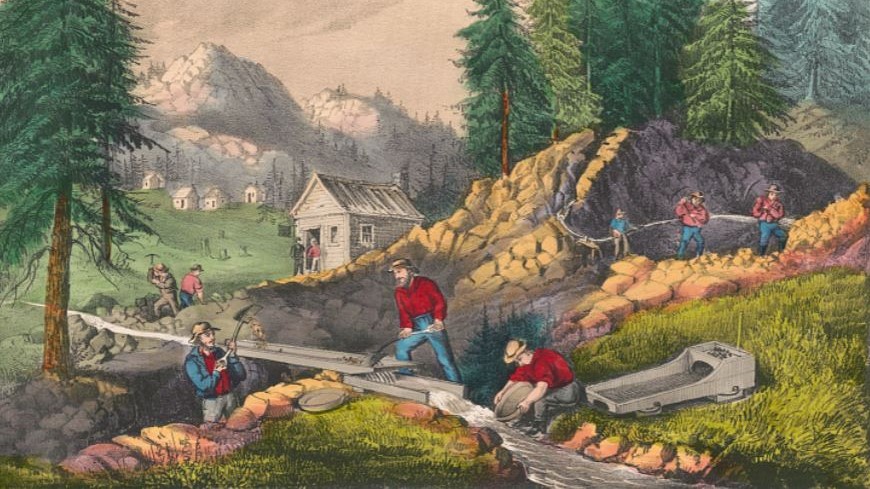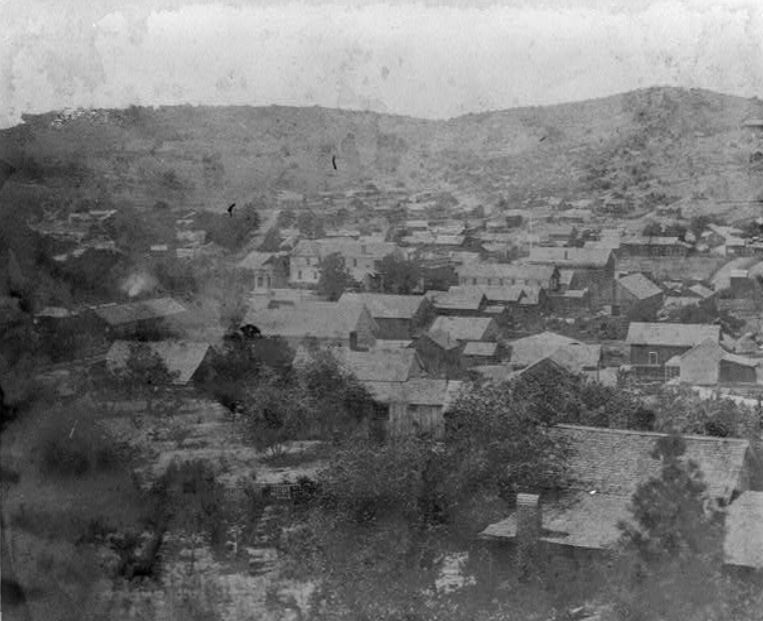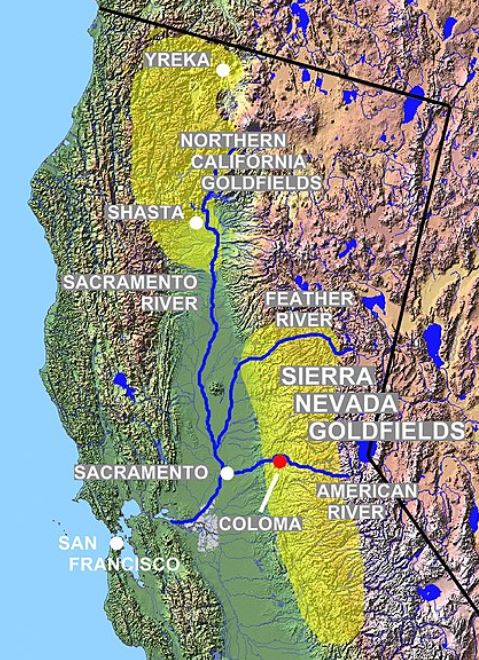The 1848 to 1855 California Gold Rush was a transformative period in American history. It drew hundreds of thousands of people into the State in pursuit of wealth and new beginnings.
While tales of fortune are often highlighted, the California Gold Rush was fraught with peril and hardship. Participants faced extreme conditions and significant risks, leading to a considerable human cost and risk of death.
This article delves into the dangers encountered during the Gold Rush and estimates the number of people who dies during this tumultuous period.
- 1. Estimates Deaths during in the California Gold Rush
- 2. The Perilous Journey to Reach California
- 3. Conditions in the California Gold Rush Mining Camps
- 4. Violence and Lawlessness was frequent during the California Gold Rush
- 5. The Number of Native Americans Who Died During the California Gold Rush
- 6. Environmental Factors
- 7. Final Thoughts on the number of people who died in the California Gold Rush
- Further Reading
1. Estimates Deaths during in the California Gold Rush

The exact number of gold miners who died in the California Gold Rush is unknown. Estimates suggest that around 10% of the roughly 300,000 prospectors, which could be around 30,000 people, may have perished during this period.
An estimated 120,000 Native Americans lost their lives during the California Gold Rush as a result of effects of violence, disease, and environmental destruction.
2. The Perilous Journey to Reach California
Prospectors reached California via treacherous routes, primarily overland trails and sea voyages.
The overland journey to join the California Gold Rush involved crossing vast plains, deserts, and mountain ranges, with extreme weather conditions posing severe threats.
Travelers frequently faced scorching heat, freezing cold, and violent storms, often unprepared for such extremes.
Supply shortages were common, leading to starvation and dehydration.
Disease was a constant companion on these journeys. Cholera and dysentery being particularly deadly.
There were many accounts of hostile encounters with Native American tribes or other groups as they passed through these lands.
Maritime routes were no less dangerous.
Sea voyages often involved long, arduous trips around Cape Horn or through the disease-ridden Panama Isthmus, where yellow fever and malaria claimed many lives.
Accurately tracking the number of prospectors who set out and those who perished during the California Gold Rush is challenging. Many journeys weren’t documented, and deaths on the trail might have gone unrecorded. But estimates suggest that these could have been in the many thousands.
3. Conditions in the California Gold Rush Mining Camps

Once in California, miners faced equally harsh conditions in overcrowded and poorly equipped mining camps.
The influx of people overwhelmed available resources, leading to inadequate shelter, food shortages, and poor sanitation. Such conditions created breeding grounds for diseases like cholera, dysentery, and malaria, which were rampant in the camps and often fatal.
Mining itself was hazardous, with accidents and cave-ins being common occurrences.
The rudimentary mining techniques and lack of proper safety measures resulted in frequent injuries and deaths.
Miners also faced prolonged exposure to hazardous materials, which could lead to chronic health issues and premature death.
Medical care was scarce and rudimentary at best. Injuries and illnesses that might have been treatable in other circumstances often proved fatal due to the lack of medical facilities and professionals.
Death from disease and accidents was common for the gold miners.
4. Violence and Lawlessness was frequent during the California Gold Rush
The California Gold Rush era was marked by significant violence and lawlessness, as the rapid population growth outpaced the establishment of formal legal and governmental structures.
Conflicts often erupted between miners over claims. This sometimes escalated into deadly confrontations.
The lack of law enforcement led to a rise in vigilante justice, where perceived offenders were punished, often without fair trials.
Relations between miners and Native Americans were frequently hostile. Racial tensions also flared, particularly against Chinese immigrants and other minority groups. This often led to violent attacks and lynchings.
5. The Number of Native Americans Who Died During the California Gold Rush
The California Gold Rush had a devastating impact on Native American populations.
Before the Gold Rush, California was home to a diverse and vibrant Native American community, with an estimated population of 150,000. However, the influx of settlers and the subsequent rush for gold led to widespread displacement, violence, and disease, drastically reducing the Native American population in the region.
One of the most significant factors contributing to the high death toll among Native Americans was violence. As tens of thousands of gold seekers flooded into California, conflicts over land and resources became frequent.
Many Native Americans were forcibly removed from their ancestral lands, and violent clashes ensued.
Militia groups and vigilante mobs often targeted Native American communities, leading to massacres and systematic killings. Historians estimate that from 1848 to 1870, between 9,000 and 16,000 Native Americans were killed as a result of these violent encounters.
Disease also played a critical role in the decline of the Native American population. The arrival of miners and settlers brought diseases such as smallpox, measles, and influenza, to which Native Americans had no immunity.
Epidemics spread rapidly through Native American communities, causing widespread fatalities. It is estimated that thousands of Native Americans died from disease during this period, compounding the effects of violence and displacement.
The destruction of land through mining activities, along with the overhunting of game and depletion of fish stocks, led to malnutrition and starvation among many Native American groups.
In total, the combined effects of violence, disease, and environmental destruction reduced the Native American population in California by approximately 80% within two decades. By 1870, fewer than 30,000 Native Americans remained, highlighting the catastrophic impact of the California Gold Rush on indigenous peoples.
6. Environmental Factors

The natural environment posed its own set of dangers to the gold seekers.
California’s landscape, with its rugged terrain and extreme weather, led to numerous fatal accidents. Miners faced threats from avalanches in the mountains, wildfires in dry seasons, and flash floods in river valleys.
Mining activities themselves sometimes triggered environmental disasters, such as landslides and mine collapses.
The relentless pursuit of gold also had a devastating impact on the natural landscape, exacerbating these hazards.
7. Final Thoughts on the number of people who died in the California Gold Rush
The California Gold Rush, while a time of opportunity and excitement, came at a significant human cost. An estimated 120,000 Native Americans lost their lives during the California Gold Rush, whilst as many as 30,000 miners are believed to have also died.
The perilous journeys, harsh living conditions, rampant disease, violence, and environmental hazards claimed the lives of tens of thousands. These sacrifices are often overshadowed by the stories of wealth and success that dominate popular narratives of the Gold Rush.
Reflecting on the Gold Rush’s history offers valuable lessons about the necessity of prioritizing human welfare and safety in any large-scale endeavor.
Further Reading
I hope you have found this blog post about How Many People Died in the California Gold Rush? interesting. To find out more about other expansions of the United States, read here:
- Who benefited the most from the California Gold Rush?
- When Did Spain Lose California?
- Why Didn’t the United States Take All of Mexico?
- What US States Used to be Mexico?
- Why did Britain want Texas Independent?
- Who Owned Alaska Before Russia?
You may also enjoy these articles exploring American history:







